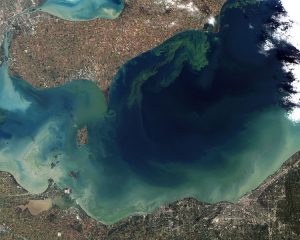
The green scum shown in this satellite image is a harmful algal bloom in Lake Erie in October 2011. Vibrant green filaments extend out from the northern shore.
Credit: NASA Earth Observatory.
Harmful algal blooms occur when colonies of algae in the ocean or freshwater systems grow out of control. These colonies of algae produce substances that are toxic or harmful to humans, fish, shellfish, marine mammals and birds.
Human illnesses caused by algal blooms, though rare, can be debilitating or even fatal. Harmful algal blooms have been reported in every U.S. coastal state, and their occurrence may be on the rise, according to NOAA.
Several American Geophysical Union scientists are available to comment on the science of algal blooms and their toxic effects on human and ecosystem health.
Nandita Basu is an associate professor of ecohydrology and water sustainability in the department of civil and environmental engineering at the University of Waterloo, Canada. Her research focuses on nutrient pollution in groundwater, rivers, lakes and coastal waters. She is particularly interested in questions related to eutrophication and algal blooms driven by decades of fertilizer use and intensive livestock production.
Email: [email protected]
Phone: +1 (226) 989-3730
Larry Brand is a professor in the department of marine biology and ecology at the University of Miami’s Rosenstiel School of Marine and Atmospheric Science. He is currently studying the causes of the 2018 harmful algal bloom along the west coast of Florida and cyanobacteria blooms in Lake Okeechobee, Caloosahatchee River, St. Lucie estuary and Florida Bay. He has also examined the concentrations of the cyanotoxin beta-Methylamino-L-alanine (BMAA) in seafood in South Florida.
Email: [email protected]
Phone: +1 (305) 421-4138
Pat Glibert is a professor at the University of Maryland Center for Environmental Science in Cambridge, Maryland. Her expertise is the relationship between nutrients and harmful algae. She focuses on how different types of nutrients and their proportions favor different types of algae growth under different environmental conditions. She is also particularly interested in how nutrient loading is changing with human activities and with changes in climate.
Email: [email protected]
Phone: +1 (410) 221-8422
Judith O’Neil is an associate research professor at the University of Maryland Center for Environmental Science in Cambridge, Maryland. Her expertise is on nutrient dynamics and grazing of phytoplankton; particularly harmful algal blooms species of both cyanobacteria and dinoflagellates in both marine and freshwater environments. Her research has included work on interactions of: open ocean cyanobacteria and Karenia blooms in the Gulf of Mexico; filamentous cyanobacteria on seagrasses in Florida and Australia; and toxic cyanobacteria in freshwater and estuarine tributaries of the Chesapeake Bay.
Email: [email protected]
Phone: +1 (410) 221-8411
Joshua Papacek is a recently graduated PhD from the University of Florida in Gainesville. His expertise is on the cycling of nitrogen and phosphorus in estuaries impacted by harmful algal blooms. He studies the various sources of these nutrients, the processes which determine their availability for different algal species, and the role of human and natural drivers on the timing and significance of blooms.
Email: [email protected]
Phone: +1 (651) 707-6678
Looking for experts in other topic areas? Visit AGU’s Stay Informed page for up-to-date expert lists.